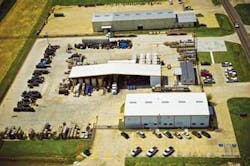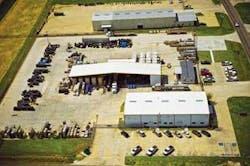Treatment chemical handling critical in deepwater
James Buis, Stephen Horner - Champion Technologies
Rigorous quality assurance has emerged as the linchpin in preparing production-critical, low-dosage chemicals to treat subsea oil and gas wells in deep and ultra deepwater. Companies have borrowed fluid cleanliness standards created for the aerospace industry by the Society of Automobile Engineers (SAE), Aerospace Industries Association, and International Organization for Standardization to classify levels of particulate contamination in certified deepwater production chemicals. Some oilfield chemical companies also have adopted chemical handling and distribution procedures to ensure deepwater production chemicals are on-spec throughout the supply chain and arrive at the offshore platform for injection uncontaminated.
Leading oilfield chemical companies in the past decade have created a new class of low-dosage, high-performance production chemicals for injection at subsea wellheads or manifolds via umbilicals or capillary strings.
But as the water depths have increased and as tieback distances from wet trees to host platforms have become ever greater, the more extreme temperature and pressure gradients to which subsea wells are being subjected have created more challenging chemical performance and delivery problems.
In some deepwater applications, technically advanced, low-dosage production chemicals are inadequate for the purpose. Severe deepwater environments can create issues with chemical stability, chemical viscosity, and contamination that can interrupt operations, force remediation or replacement of subsea injection and/or production components, or require operators to completely rethink chemical treatment strategy. The consequences of a chemical treatment failure in unforgiving deepwater applications can be extremely costly.
Assuring quality
Assuring that a specialty chemical is qualified to treat corrosion, hydrate, wax, asphaltene, or scale problems in deepwater wells begins with initial design and testing at the chemical manufacturing plant and extends through transportation to a deepwater chemical certification facility. Each step in the deepwater certification process must be taken, through delivery to an offshore production facility and the actual injection process.
At the manufacturing facility a chemical formulation’s physical specifications, performance characteristics, and compatibility with produced fluids, other production system chemicals, and materials of construction are established. A good deepwater production chemical should:
- Be robust in performance
- Exhibit appropriate viscosity and stability across a wide range of temperatures and pressures
- Reflect a high degree of solubility
- Have potential for broad treatment applications.
All these goals require that appropriate grades of raw materials and intermediary components are used in a standardized manufacturing process and that the chemical formulation meets specifications identified through rigorous research and testing. Work-off, the practice of holding down manufacturing costs by blending off-spec chemicals into new batches, should not be allowed in the manufacture of a deepwater chemical because it adds an unnecessary level of uncertainty.
During manufacture, the stability of a chemical destined for subsea injection should be verified at the extreme temperatures it will encounter in deepwater. Viscosity should be tested at the temperatures and pressures it will see during injection to determine its pumpability. An umbilical-certified deepwater chemical product should undergo more rigorous qualification processes and certification testing than a chemical that is to be injected into the production system at the surface, whether onshore or offshore.
Subsea injection system
Equally important is the design of subsea umbilicals or capillary injection systems used to inject the chemical at a subsea wellhead. Umbilical length and diameter, production system temperature and pressure gradients, and pump design and rate all combine with wellhead pressure and treatment chemical characteristics to create an injection system’s operating parameters.
System reliability and functionality are crucial in subsea chemical injection systems. Once a chemical is pumped into an umbilical, a delivery problem quickly can become a multi-million dollar mistake. Any particulate contaminants in a treatment chemical can accumulate at bends in treatment lines or at fittings and connections to create bottlenecks that raise the risk of blockages which interrupt chemical treatment. In addition, subsea oil and gas projects frequently incorporate umbilicals or capillary strings that are many miles in length, as opposed to a few thousand feet, at most, just a few years ago.
Ironically, the combination of long-distance tiebacks and minimal treatment volumes required of low-dosage production chemicals significantly increase the residence time for deepwater chemical in a treatment line, exacerbating risks of plugging or delivery impairment. If a plugged chemical injection line halts treatment with a production-critical chemical, such as a low-dosage hydrate inhibitor, the failure can result in breakdown of the project’s flow assurance program.
An experienced deepwater chemical advisor can recommend subsea production system designs and chemical cleanliness specifications to help a producer avoid mechanical failures and capillary restrictions when given reservoir characteristics, composition of the production stream, depth of water at the well site, and tieback distance on a given project.
Filtering impurities
Before transport, a deepwater production chemical should run through a rigorous quality assurance process to verify the product is properly formulated and free of particulate contamination. Chemical companies have established deepwater chemical certification and distribution facilities equipped with technical support laboratories for this purpose.
Special measures must be taken each time the chemical is handled to ensure it is not contaminated by anything that could interfere with its performance before it is delivered to the customer. Dedicated pumps, hoses, and containers should be used at each step of processing or each change of custody.
For example, when the deepwater chemical arrives at the certification facility, lab technicians should collect samples in sterile jars for testing to confirm the chemical’s composition and to check for contamination. If possible, the certification lab should have a clean room where samples can be tested prior to particle-size analysis.
After the formulation of the samples is verified, the chemical should be run through a particle-size analyzer, which passes a laser through the solution to count the number of particles present and the distribution of particle sizes. If too many particles are present, the chemical is then run through a series of filters to remove the excess.
SAE pure
Chemists describe the cleanliness of a chemical substance in terms of its classification according to SAE Aerospace Standard (AS) 4059, which indicates the count of particles within each of several particle-size ranges. The higher the SAE AS4059 classification, the greater the numbers of particulate contaminants present and the larger the particle sizes allowed. For example, 100 ml (3.4 oz) of a Class 5 chemical should have no more than 25,000 particles larger than 1 micron at the longest dimension in (as measured by optical microscope) and:
- No more than 9,730 of the particles would be more than 5 microns in diameter
- No more than 1,730 of the particles would be more than 15 microns in diameter
- No more than 306 of the particles would be more than 25 microns in diameter
- No more than 53 of the particles would be more than 50 microns in diameter
- No more than eight of the particles would be more than 100 microns in diameter.
The objective of the filtration process is to purify a deepwater chemical to the SAE specification required for subsea injection at a specific deepwater location. Once a chemical has been deepwater certified, it is loaded into clean tanks, at which point composition and cleanliness should be verified again before it is loaded onto a supply boat for delivery.
Such rigorous quality assurance processes must be strictly enforced at each step of design, manufacturing, testing, filtering, and delivery. This ensures deepwater chemical product specifications and cleanliness are maintained and the producer receives deepwater certified production chemicals tailored to work flawlessly in the subsea injection system.
Aerospace Fluid Power - Cleanliness Classification for Hydraulic Fluids
SAE Aerospace Standard: AS4059
Revision Number: E
Date Published: May 2005
This SAE Aerospace Standard (AS) defines cleanliness classes for particulate contamination of hydraulic fluids and includes methods of reporting related data. The contamination classes selected are an extension based on the widely accepted NAS 1638 cleanliness classes. Conversion from NAS 1638 cleanliness class specifications to AS4059 class specifications is defined. Comparison of the NAS 1638 classes to AS4059 classes is defined and the differences explained.
This document provides versatility in identifying a maximum class in multiple size ranges, total number of particles larger than a specific size or designating a class for each size.
NAS 1638 classes based on weight of particles are not applicable and are not included.

